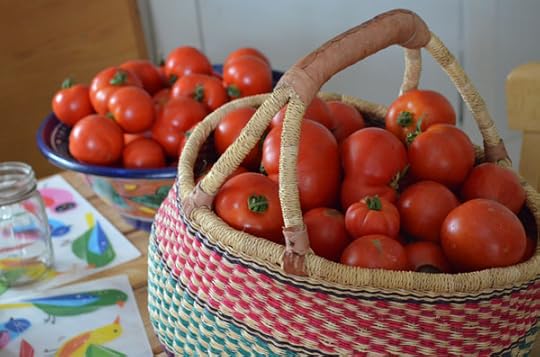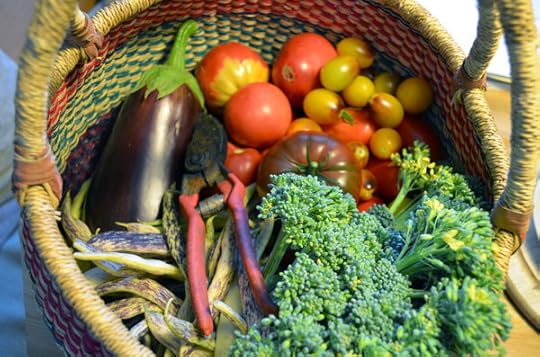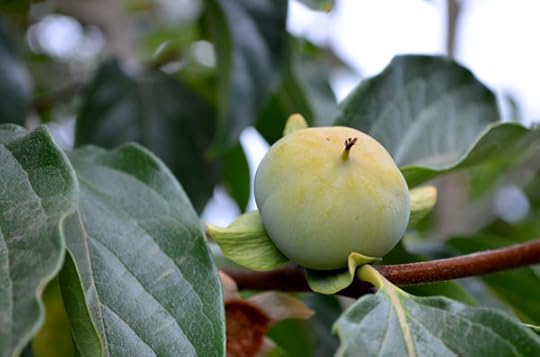Renee Wilkinson's Blog, page 15
October 9, 2013
Visiting Joshua Tree
I was entranced by the flora of southern California on our recent trip down south – not to mention the fabulous edibles that thrive in this region. We ventured in Joshua Tree for a few days to attend a wedding and we carved out a little time to explore this distinct, unusual landscape.
 Joshua Tree is a nation park that stretches over the higher elevation Mojave Desert and the lower elevation Colorado Desert, just a couple hours east of Los Angeles. The area we were in was the northern side of the park. The dry desert here was rocky and somewhat barren to my northwestern eyes, although I can still see the beauty in that starkness.
Joshua Tree is a nation park that stretches over the higher elevation Mojave Desert and the lower elevation Colorado Desert, just a couple hours east of Los Angeles. The area we were in was the northern side of the park. The dry desert here was rocky and somewhat barren to my northwestern eyes, although I can still see the beauty in that starkness.

It’s a landscape of contrasts – the brilliant blue sky against the washed out boulders. Color bursts from the landscape when you stop to look closer. And the textures range from the sharp spikes of a cactus to the lush curves of a succulent.

Groves of resilient trees stand tall and gentle wave toward each other, as if they are keeping each other company in this wide, open desert. There are signs all around of life persistently enduring, like the birds nest we discovered nestled into a cactus branch.
Just as hiking through the gorge is a celebration of the temperate rainforest I live in, Joshua Tree is a celebration of the dry desert surrounding Los Angeles and San Diego. For those who live in this region, it’s inspiration for designing succulent planters to greet you at your doorstep or a model for a drought-tolerant front yard.

It was also a chance to make memories with our family at one of the great national parks! We bought Juniper a national parks “passport” and we’re looking forward to putting more stamps in it over the years.

Have you been to Joshua Tree before? If so, what was your impression? If not, what is one of your favorite national parks that gives you some inspiration to use at home?
October 2, 2013
SoCal Edible Plants
I recently shared my adventures through the San Diego Botanical Gardens, but this post is all about edibles. Most of us live in climates where we’re thinking now about pulling out the tomatoes and growing cold-hardy crops. But let’s ignore the howl of the wind through the windows and drool over these pictures, dreaming together of what we can’t grow in our backyards.

Panache Fig
Figs are incredibly versatile edible trees, in part because they are one of the oldest trees with fossil records showing their existence thousands and thousands of years ago. You can likely find one from a good nursery to fit your climate. This lovely fig with gorgeous strips is a Panache Fig, which ripens best in warm, inland climates.

Banana grove with limbs bent over with fruit
In climates with milder cold seasons, it’s possible to grow some tropicals like leafy banana plants. I see them around Portland, often bundled up with straw to make it through really cold spells. But I’ve never seen a banana tree bent over from ripening fruit.

Avocado tree
Avocados… I love them, but feel guilty buying them since they travel long distances to get to my market. This massive tree was just dripping with fruit. I was a good girl and didn’t pick a single one 

Huge kumquat tree
Some of these edibles, especially citrus, you can grow in colder climates, if you plant them in containers that you bring inside during the cold months. I have a gorgeous kumquat “house plant” that I get some fruit from here and there, but it doesn’t compare to this large kumquat tree – at least 10′ high.

Pink Lemonade Lemon
Again, lemon trees can still produce fruit as a house plant. My little Meyer Lemon has given me some nice ones over the years. But I’ve never had the pleasure of seeing this Pink Lemonade Lemon, with cool variegated skin.
Macadamian Nut Tree
Macadamian trees were dropping fruit left and right. Like a walnut, it looks like the edible part is the hard nut inside these green fruits.

Pomegranate tree bent gracefully with fruit
And pomegranates! They produce stunning, golden foliage in autumn, so people in the Pacific Northwest often grow them just for the show. But I’ve never seen them develop actual fruit in my area.
Of course we’re happy to be home – I take that as a sign we’re living in the right place – but I can see why folks love growing gardens in San Diego. Do you have some favorite edibles you drool over, but can’t grow in your climate? Tell me about in the comments below!
September 23, 2013
Botanicals of San Diego
Traveling with kids slows you down quite a bit, but we are learning to settle into a rhythm with Juniper as our regular traveling partner. This time our travels took us to southern California, a couple days of which were spent in sunny San Diego.
 An excellent, kid-friendly outing was spent at the San Diego Botanical Gardens. They have a fabulous Children’s Garden that includes a trickling stream where the kids can cool down on a hot afternoon. Amazing how just a little water can make a place feel so much cooler.
An excellent, kid-friendly outing was spent at the San Diego Botanical Gardens. They have a fabulous Children’s Garden that includes a trickling stream where the kids can cool down on a hot afternoon. Amazing how just a little water can make a place feel so much cooler.

They also have a treehouse that looks absolutely wild! Ropes and plants are tangled up into this whimsical, nature-based adventureland.

While Juniper was spending time with her cousin exploring the Children’s Garden, I was dashing through the various gardens oogling plants. Lots, and lots, of plants.
I suppose the grass is always greener on the other side of the fence, but I found myself drooling over the stunning SoCal plant palette. My mind always races to the Blue Flame Agave when I think of this region.

And the succulents? Oh gosh… don’t even get me started. They covered rooftops, filled windowboxes and spilled into paths.

I’m convinced every San Diego residence needs a huge, unglazed ceramic pot greeting visitors at the entrance packed with a stately cactus grouping. The geometry looks so formal and this has to be one of the lowest low-maintenance container ideas ever.

Cannas were around every corner all over San Diego, were they thrive. I don’t dare grown them at home in Portland because they are just-barely/not-quite hardy enough (depending on who you ask) for our climate.

Some of the trees in the gardens were so ancient looking, like this Mysore Fig. The fruit isn’t worth eating on this particular tree, which instead prized for it’s large, glossy foliage.

Not every plant was well marked, like this white succulent with red-hot tips.

And Dr. Seuss-like trees popped up around corners like an unexpected jokester.

The other highlight of our short visit was spending an evening on the beach with loved ones. We let our kids run around together exploring the sand and shrieking with delight.

The water was just warm enough for learning how to jump waves. And watching the sunset with surfers bobbing up and down on the waves was magical.

We didn’t see most of what the city had to offer, but we savored what we saw with Juniper. I can’t wait to show you more pictures in my next post about the edible plants of San Diego and our trip into the desert of Joshua Tree.
September 11, 2013
Fresh Tomato Soup
I have been busily canning stewed tomatoes, marinara sauce and ketchup, but still the harvest basket fills with tomatoes. Roasting fresh tomatoes with garden onions and garlic is an easy way to blow through that late summer harvest.
So. many. tomatoes.
Sauce tomatoes work best, like the delicious San Marzanos. But any old mix of tomatoes will work – just roast a bit longer for slicer tomatoes that are more watery.
San Marzano sauce tomatoes are perfect for fresh tomato soup
This recipe is based on one from the Apples to Zucchini cookbook – an incredibly vegetarian cookbook. It was originally written for people who need to eat a low-protein diet, like my nephew who has the metabolic disease PKU. However, it has earned it’s place on our homestead due to the vast number of delicious vegetarian recipes it includes. They can all be left as written for people on a low-protein diet or easily adapted for those of us without dietary restrictions.
Apples to Zucchini by Virginia Schuett and Dorothy Corry
Be warned that the cookbook does not include photographs. It’s really just a no-nonsense guide to cooking with vegetable-based meals with options to add in cheese, beans or rice to many of the dishes to increase the protein. It’s hard to find, but use the link above to track it down.
Roasted fresh tomatoes with onions and garlic
Okay, back to the soup… The recipe basically slow roasts the tomatoes and I’d estimate it takes about two hours from start to finish. I have a child, so that’s not doable on a weeknight EXCEPT I make the soup after dinner. It doesn’t require a lot of active time, just slow cooking time. I cook it up when the house cools down for the evening, blend it up and save it for the next day. It’s easy to reheat or enjoy cold.
Fresh tomato soup
Fresh Tomato Soup
twenty fresh tomatoes, halved with skins on
10-15 cloves garlic left in skin
2 onions, roughly quartered
1/4 cup olive oil
1/2 tsp salt and pepper
1/4 tsp dried red chili flakes
2 T. dried basil
2 c. vegetable broth
1 quart chopped tomatoes (I actually use a quart of home canned, but you can use fresh too)
2 T sugar
creme fraiche, sour cream or heavy cream to garnish
In a large mixing bowl, toss tomatoes, garlic and onions with enough olive oil to lightly coat, about 1/4 cup. Pour onto a rimmed baking sheet and sprinkle with salt and pepper. Roast for 45 minutes in the oven at 425 degrees.
When the tomatoes are wrinkly and the onion is soft, remove from the oven and pour everything into a big stock pot. Dig out the garlic cloves and press them out from their skins, discarding the papery skins. Add red chili flakes, basil and broth. Bring to a boil, then simmer for 30 minutes.
Blend with an immersion blender or work in batches with standing blender, only filled halfway since the mixture expands when the blender is on. Once pureed, return to stock pot and add the quart of roughly chopped tomatoes and the sugar. Return to a simmer for fifteen minutes. Adjust consistency with more water if desired and taste to make sure the sugar/salt/pepper balance is right. Serve warm or cold with a dollop of cream (either creme fraiche, sour cream or heavy cream) and crusty bread.
Fresh tomato soup
I suspect the soup freezes well, but haven’t experimented with that yet. The dollop of cream gives it a needed depth because, as delicious as roasted tomatoes are, it can be a bit flat otherwise. I bet some roasted red peppers would be a great addition as well, so play around with it. Hope you enjoy it as much as we did!
September 9, 2013
September Harvest
It’s still summertime on our homestead in September. Let’s take a little walk through the garden together.
September harvest basket
The harvest basket includes everything from eggplant to green beans, or rather Dragon’s Tongue beans. They are long with purple strips that taste great fresh or sauteed with tons of garlic.
Our tomato taste-tester
Tomatoes are coming on strong and Juniper is learning that the green ones don’t taste so good. Well, unless you’re growing Green Zebra tomatoes which we are not.
Pink Oxheart tomatoes
We’re growing an assortment that includes San Marzano, Brandywine, Pineapple, Cherokee Purple, Pink Oxheart and Kumquat Cherry. It’s hard to pick a favorite since I like them all mixed together.
Sunchokes standing over six feet high and ready to bloom
Sunchokes bloom like a sunflower but the tubers taste like an artichoke heart, hence the name sun-choke. They are standing tall, reaching for the sky, but no flowers yet. They are a fall bloomer that should unfold any day now. We harvest them through the winter, like our potatoes.
Asian persimmon fruit ripening
The asian persimmon tree is covered with fruit this year! They will turn dark orange in November, but are just starting to blush now.
Raspberries in September
Why doesn’t everyone plant ever-bearing raspberries? We have been grazing on these all summer long. They start around June and continue to bear delicious berries through October.
Dried artichoke
And my favorite – artichokes. The flowers I allowed to bloom are drying up for winter time, although you can still catch some bees here and there looking for pollen. It’s my signal every late summer that days are getting shorter, nights are getting colder and it’s time to think about scarves and stew. After a productive season, I’m ready for that winter break.
September 3, 2013
High Desert Family Vacation
Every summer we flock to the high desert country around Bend, Oregon, for our version of a family vacation. After 30+ years of vacationing there, the trip always seems to mark a moment in time for me.
Juniper on my back for the morning walk
I take morning walks when the deer are awake, but most people are still in bed. Juniper joined me in the Ergo, which for you non-parents-of-wee-ones is a backpack baby carrier thing. (Totally expensive, but we’re found it incredibly useful 18 months into parenthood.)
 We love spending a significant portion of the vacation on our bikes. This year I found a secondhand Co-Pilot bike seat to attach to my bike, so Juniper could now join me on long rides. Juniper is now a pro at spotting deer crossing our path, although she’s not sure what sound a deer makes.
We love spending a significant portion of the vacation on our bikes. This year I found a secondhand Co-Pilot bike seat to attach to my bike, so Juniper could now join me on long rides. Juniper is now a pro at spotting deer crossing our path, although she’s not sure what sound a deer makes.
 A few times we happened upon a heron fishing in the river. I love the kind of vacation that includes my baby learning about the natural world.
A few times we happened upon a heron fishing in the river. I love the kind of vacation that includes my baby learning about the natural world.
 This year’s trip coincided with the Bend Brewfest, which is a surprisingly kid-friendly event at the Les Schawb Ampitheater. It reminded me of Germany to have little ones running around while adults sipped some cold brew.
This year’s trip coincided with the Bend Brewfest, which is a surprisingly kid-friendly event at the Les Schawb Ampitheater. It reminded me of Germany to have little ones running around while adults sipped some cold brew.
Juniper & I enjoying the high desert and going with the flow
Last year we wasted a lot of time trying to force nap time on Juniper or stick to a schedule that we somehow thought would maximize our vacation fun. This year we let it all go and had more fun than I think we ever have had there. I’m excited to help create a whole new lifetime of memories there for Junebug.
August 27, 2013
Front Yard – Summer Update
The bright greens and purples of our lush front garden in springtime has faded to the yellow and tans of late summer. This past winter I dug up and divided several perennials from the front garden, arranging and replanting them to fill in empty spaces. After a few years of this routine, the entrance to our homestead is getting more and more welcoming.
Front yard in August 2013
Euphorbia produces these fabulous chartreuse spikes in spring, which have now faded to tan. This plant is somewhat opportunistic. It reseeds freely, so many new plants are taking root here and there. In the Pacific Northwest, Euphorbia is a semi-evergreen that should hold on through our mild winters.
Euphorbia is late summer with dried flower stalks
Lamb’s ear is a tough perennial that is evergreen in our mild climate as well. I love the grey-green, velvet-like texture of the leaves. The flower spikes that bloom pink in early summer have dried out completely. The bees that flock to them have moved on to other nectar plants.
Lamb’s ear in summer with dried flower stalks
A few blooms pop up here and there, like this drought-tolerant Rudbeckia. I’m looking forward to planting several more next season. The sage in the background thrives in our hot, west-facing garden providing a lushness during an otherwise parched time of year.
Flowering Rudbeckia and lush sage in late summer
Come late fall, I will go through the front yard to cut off the brown flower pods from the Euphorbia and Lamb’s Ear. I will likely cut and divide more perennials to keep stuffing the garden with drought-tolerant, low maintenance plants. For the time being though, the front garden is a reflection of the season – dry, hazy and just hanging on through these last long days of summer.
August 15, 2013
Imperfection
I had a recent revelation when I was sharing some fruit from our garden with friends and coworkers this summer. All around me, I am happily living with imperfection.
Imperfect figs that made a fabulous summer salad
On one occasion, I was sharing a bowl full of perfectly ripe figs. When someone from the group spotted a fruit fly circling above, almost all of them turned their noses up at trying the delicious jewels. Fresh figs and no one wanted one? I couldn’t believe it…
Imperfect apricots ready for the canning pot
And on another occasion, a friend was no longer interested in a fresh apricot after noticing some pocking on the skin from a late frost. The fruit was perfectly sweet and juicy, but the appearance of a small blemish was enough to turn them away.
Imperfect eggs
As a gardener, and maybe one that has had this many seasons of toiling in the soil, I came to the realization that imperfection surrounds my garden and home. The eggs have smudges of dirt on them. There are usually fragments of straw from the chicken coop that somehow make their way into our living room. The kitchen is cluttered with big canning pots and an assortment of filled and empty jars.

Imperfect apricots and blackberries that made one hell of a jam
I see past all of that now. Working to grow what we eat is a labor of love and small blemishes can’t stop me from enjoying the fruits of my labor. It’s only when people who are not living some version of modern homesteading point it out to me that I even notice these imperfections.
I wasn’t embarrassed about the figs or the apricots. If anything, I was disappointed they would not be experiencing a bite of summer – something they won’t get in the grocery story or off the shelf. The sugars were perfectly developed and the skin was hot from the summer sun. I’ll take those experiences in trade for some less-than-perfect fruit any old day.
July 30, 2013
What? It’s the End of July??
How did it become the end of July? I feel like this summer is slipping by so quickly this year. Maybe that’s part of getting older. Nah… I like to think it’s more related to living close to the land.
Artichokes in full summer bloom
I’m noticing artichoke flowers getting so huge and open that they topple over from their own weight.
My garden waterer
Juniper could hardly hold the hose a few weeks ago, but now she’s an expert garden waterer.
One of the three harvest baskets full of apricots
The apricot tree is bare, picked clean of fruit. The fig tree is now bent over with probably a hundred pounds of figs.
Mmmmmm… pie….
We’ve enjoyed summer through pies: strawberry-rhubarb, blueberry, blackberry and peach to name a few.
There’s still the hot, long days of August ahead which I look forward to all year. But I’m afraid it will pass by in a blink as well. Is it just me, or are these long days just not long enough??
July 24, 2013
Apricot-Rosemary Preserves
Our Puget Gold apricot tree has been prolific this year! This variety of apricot was developed in Washington and is particularly well-suited for the Pacific Northwest, with our late cool springs. They are self-fertile, meaning you only need one to get fruit. Apricots are a finicky fruit tree that doesn’t grow well in much of the country, so you may have live vicariously through this blog post if you can’t grow them in your area.
Puget Gold apricot tree bent over with fruit
Since moving back into our house last year, I have been struggling with removing blight, a bacterial canker, from our affected Apricot tree. It’s a problem in areas that have wet springs, like Portland, but can be treated by applying an organic copper spray during the dormant season. I sprayed our tree a couple times, which did seem to make a dent in our problem, but there were still plenty of branches with pocked fruit.
Bacterial canker, or blight, effected apricot fruit
The tree has been just bent over dripping with fruit. It seems healthy overall and eating the fruit with pocked skin won’t hurt you. So all in all, I’m still a fan of the apricot tree even though it needs a little more TLC than our other fruit trees. I think another year of applying the copper spray will hopefully kick the canker completely.
You don’t see apricots and figs sold fresh in the grocery store that often, although gourmet food stores carry them from time to time. That is because they are only really good about a day or two after being picked from the tree. The fruit is tender and gets over-ripe very quickly. So imagine having fifty (yes fifty!) pounds of apricots in the harvest basket, or rather baskets.
Apricot harvest ready for preserving
I love dried apricots, but I wanted something I couldn’t easily buy. Instead, I’m focused on cranking out batches and batches of apricot preserves. They are great with sweet and savory dishes. We’ll gobble them up at home, but they are unusual enough to make fabulous gifts as well (I’m already thinking about the holiday season). More recipes will likely follow, but here is a keeper I cooked up the other day.
Apricots, sugar and lemon juice
Apricot-Rosemary Preserves
5 lbs fresh apricots, halved and pitted
4 c. sugar
1/3 c. lemon juice
1-2 T. fresh rosemary, chopped
Don’t waste your time peeling the apricots. The skins are so thin and delicate, they will pretty much dissolve during the cooking process. And the skin adds flavor and fragrance you don’t want to omit.
Toss apricots, sugar and lemon juice in a large stock pot. Set aside for four hours or overnight in the fridge.
Bring to a slow boil, being careful to stir often to prevent any sticking. Boil the mixture down by about half until thickened. I test mine by taking a spoonful, cooling it down, then turning the spoon on it’s side. If it’s a gel-like consistency, it’s ready. If it’s too watery, it needs more time cooking.
Remove the pot of preserves from heat. Then stir in 1 tablespoon of the fresh rosemary. Once combined, do a taste test and decide whether to add another tablespoon. It can easily over power the apricot flavor.
When you’re ready, carefully pour preserves into your clean, sterilized canning jays (I like 1/2 pints or full pints). Wipe the rims clean and adjust two-piece caps. Boil in hot water bath for fifteen minutes.
Fresh rosemary ready to mix in at the end of cooking
Some herbs take on a bitter taste when they are overcooked, which is why I turn the rosemary in at the end of the cooking. You’ll get a nice floral rosemary flavor without it being total overwhelming. It will still a cook a bit in the short time it’s in the hot water bath, but not long enough to get bitter.
Pint jars filled with heavenly apricot-rosemary preserves
We discovered these preserves are perfect with pork dishes. We cooked up thick, 1″ center-cut boneless pork chops – about five minutes on each side over low-medium heat. Once cooked to your liking, just dollop some of these preserves on top at the table. Get ready to fall in love with apricots!






































